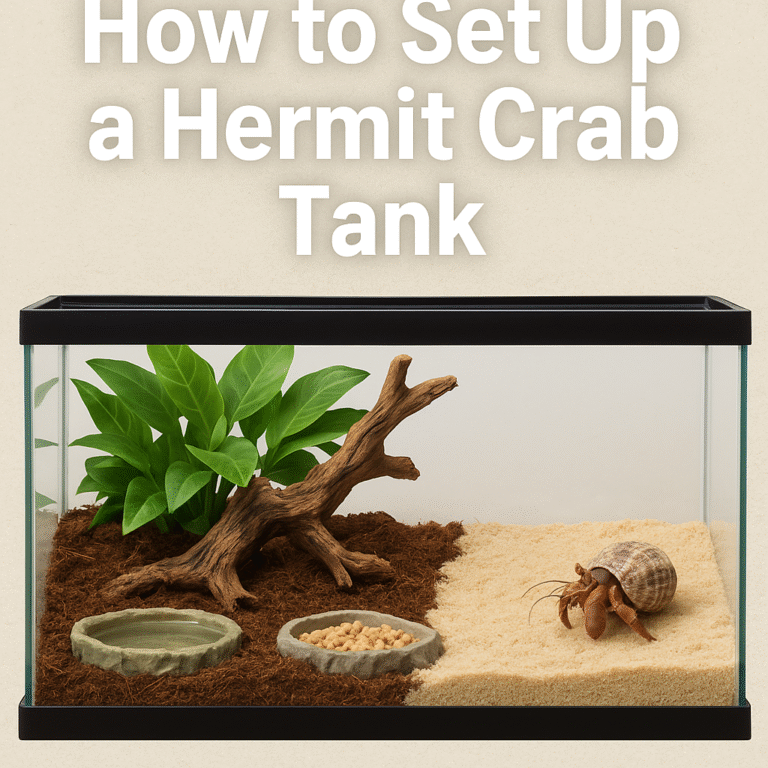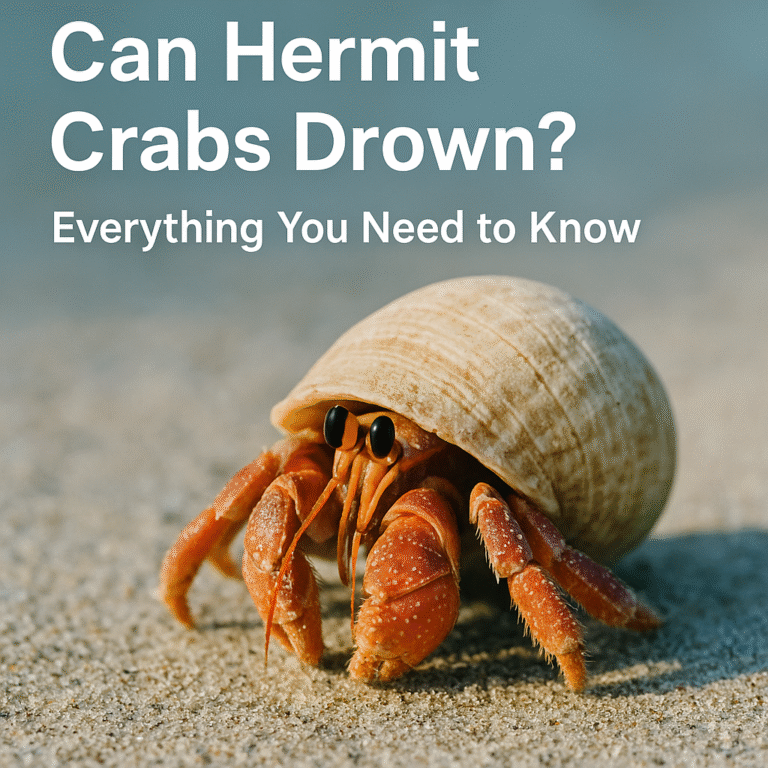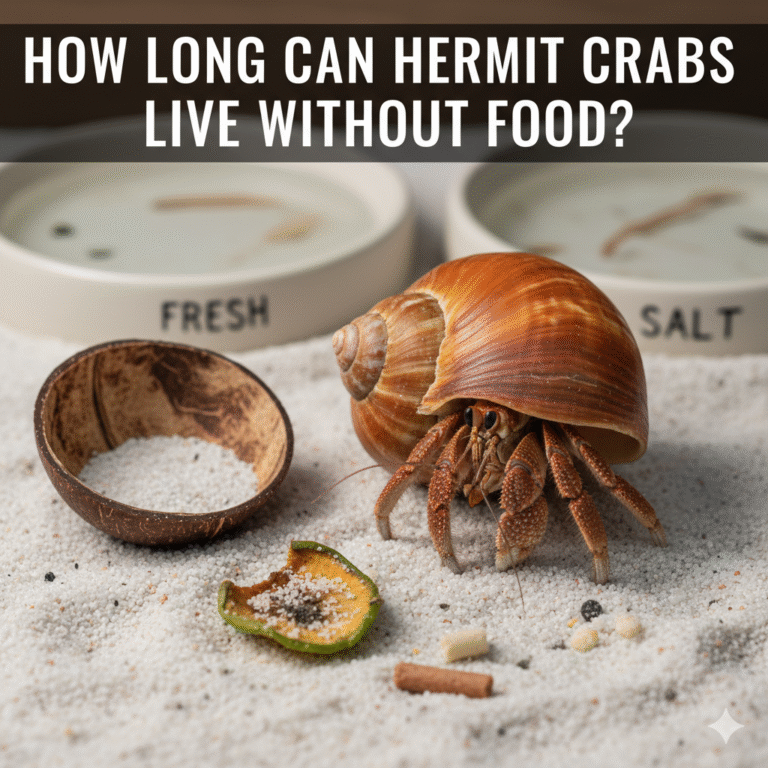Hermit Crab Care for Beginners: Complete Guide (2025)
Thinking about keeping a hermit crab as a pet? These fascinating little creatures are low-maintenance, fun to watch, and unlike any other pet you’ll ever own. But even though they’re small, hermit crabs still need the right environment, food, and care to thrive.
In this beginner-friendly guide, we’ll walk through everything you need to know – from tank setup and diet to shells, behavior, and common beginner mistakes. By the end, you’ll have a clear picture of how to give your hermit crab a comfortable home.
Why Hermit Crabs Make Great Pets
Hermit crabs are not your typical pet. They don’t cuddle like cats or play fetch like dogs, but they bring a different kind of charm:
- 🦀 Unique behaviors: Watching them change shells, dig, or climb is fascinating.
- 🌍 Small space requirements: Perfect for people with limited room.
- 🏡 Low daily maintenance: Once their tank is set up, they’re relatively easy to care for.
- 👨 Family-friendly: Kids love learning about their quirky habits.
Many beginners believe hermit crabs only live a few months. In reality, with proper care, they can live for years, which makes them a surprisingly rewarding long-term pet.
Types of Hermit Crab
There are hundreds of hermit crab species, but only a few are commonly kept as pets:
- Caribbean Hermit Crab (Coenobita clypeatus): One of the most popular pet species, often called the “Purple Pincher.”
- Ecuadorian Hermit Crab (Coenobita compressus): Known for being smaller and faster.
- Indonesian Hermit Crab: Often sold in pet shops, recognized by their lighter coloring.
For beginners, any of these common species work well. The basics of care are similar across them.
Setting Up the Perfect Hermit Crab Tank
Your hermit crab’s tank (often called a “crabitat”) is its entire world. Setting it up correctly is the most important step for keeping your crab happy.
Tank Size
- A 10-gallon tank works for 1-2 crabs.
- If you want 3-5 crabs, aim for at least 20 gallons.
For more background, the Smithsonian’s National Zoo guide to hermit crabs explains how these creatures live in the wild, which helps you mimic the right conditions at home.
Substrate
Hermit crabs love to dig, especially during molting.
- Use sand or coconut fiber as substrate.
- Depth: at least 3-6 inches so they can burrow fully.
- Avoid gravel – it’s too hard and uncomfortable.
Temperature & Humidity
Hermit crabs are tropical animals, so they need warmth and moisture.
- Place the tank in a warm room away from direct sunlight.
- Mist the tank lightly to keep humidity levels comfortable.
- Good airflow is important – cover the tank with a ventilated lid.
Lighting & Day/Night Cycle
Hermit crabs are nocturnal, but they still benefit from a natural day/night rhythm.
- Place the tank in a room with natural light.
- Optional: use a low-wattage bulb to simulate daylight if the room is dark.
Decor & Hiding Spots
Hermit crabs are explorers. Give them things to climb and hide in:
- Driftwood, rocks, and artificial plants.
- Small caves or coconut huts.
- Multiple shells scattered throughout the tank.
Water Needs
Hermit crabs need access to both fresh water and salt water.
- Provide two shallow dishes: one with dechlorinated fresh water, one with marine salt water.
- Bowls should be shallow enough for them to climb in and out.
- Never use table salt – only marine-grade salt.
What Do Hermit Crabs Eat?
Hermit crabs are omnivores, meaning they eat a mix of plant and animal foods.
Safe Foods
- Fruits: apples, bananas, grapes, melon, mango.
- Vegetables: cucumber, carrots, spinach, lettuce, zucchini.
- Proteins (occasionally): boiled egg, plain cooked chicken or fish.
- Store-bought food: Hermit crab pellets as a backup option.
Foods to Avoid
- Salty, sugary, or processed human snacks.
- Chocolate and citrus.
- Anything with preservatives.
Feeding Tips
- Replace food daily to keep it fresh.
- Offer a mix across the week so they get variety.
- Remove uneaten food before it spoils.
💡 Example weekly plan:
- Monday: Apple slices + cucumber.
- Tuesday: Carrots + spinach.
- Wednesday: Banana + a small piece of boiled egg.
- Thursday: Grapes + lettuce.
- Friday: Zucchini + melon.
- Weekend: Store-bought pellets + fruit treat.
For a detailed list of safe and unsafe foods, the Hermit Crab Association has a helpful community-maintained food chart. You can also check The Spruce Pets’ hermit crab diet guide for quick references.
Shells and Molting
Hermit crabs don’t grow their own shells – they rely on empty snail shells for protection.
Extra Shells
- Always keep 2-3 extra shells per crab in the tank.
- Choose natural, unpainted shells.
- Provide different sizes so they can upgrade when needed.
Molting
Molting is when hermit crabs shed their exoskeleton to grow.
- They usually bury themselves during this process.
- Molting can last from days to weeks.
- Do not disturb a crab while it’s buried.
Handling & Interaction
Hermit crabs are fun to watch, but they’re not “cuddly pets.” Still, you can interact with them carefully.
- Always wash your hands before and after handling.
- Let them crawl on your hand instead of grabbing them.
- Avoid handling too often – it can stress them out.
Common Behavior You’ll Notice
Hermit crabs have some unique quirks:
- Climbing: They love vertical surfaces.
- Burying: A natural habit, especially during molting.
- Shell swapping: They may inspect multiple shells before choosing one.
- Noises: Hermit crabs sometimes chirp or tap, especially at night.
Beginner Shopping Checklist
Before you bring a hermit crab home, make sure you have:
- Glass tank (10-20 gallons).
- Substrate (sand or coconut fiber).
- Two water bowls (fresh + salt).
- Marine salt for salt water.
- Driftwood or climbing decorations.
- Extra shells of various sizes.
- Food (fresh fruits/veggies + pellets).
- Spray bottle for misting.
Fun Facts About Hermit Crabs
- They are nocturnal and most active at night.
- They communicate with each other using chirping sounds.
- In the wild, they often live in large social groups.
- Some hermit crabs can live more than 10 years.
- They are natural recyclers, using discarded shells for protection.
- They can walk in any direction – not just sideways.
- Hermit crabs sometimes “try on” shells before deciding to move in.
- They breathe through gills, so humidity is essential.
- Despite the name, they are social and prefer company.
- Hermit crabs have been kept as pets for decades around the world.
Hermit crabs are quirky, entertaining, and packed with surprises. If you’d like to dive deeper, National Geographic’s hermit crab facts highlight their unique behaviors in nature.
Beginner Mistakes to Avoid
- ❌ Using gravel as substrate.
- ❌ Not providing enough extra shells.
- ❌ Keeping just one crab (they are social).
- ❌ Using painted shells.
- ❌ Overhandling them daily.
- ❌ Forgetting to provide both fresh and salt water.
Lifespan Myths
Many people assume hermit crabs only live for a few months. This belief comes from pet stores, where crabs often don’t get the right care.
In reality, with the correct tank, food, and environment, hermit crabs can live for 5-10 years or more. That makes them much more than a “temporary pet.”
Conclusion
Hermit crabs may be tiny, but they bring endless fascination into your home. By setting up a proper tank, offering the right foods, and respecting their natural behaviors, you’ll give them a safe and enjoyable environment.
Whether you’re new to pets or just curious about these unique creatures, hermit crabs are a fun and rewarding choice. You can explore even more guides and tips on our Hermit Crab Blog to continue learning.
FAQs About Hermit Crab Care
Do hermit crabs make good pets for kids?
Yes, but kids should be supervised when handling them.
How often do hermit crabs need new shells?
There’s no fixed timeline. They change shells when they outgrow the old one.
Do hermit crabs pinch?
Yes, but only if they feel threatened.
Can hermit crabs live alone?
They can, but it’s better to keep at least two or three together.
Do hermit crabs smell bad?
A healthy crab doesn’t smell. If the tank smells, it usually means old food or waste needs cleaning.
Do hermit crabs need heat lamps?
Not always, but they do need a warm environment. A naturally warm room usually works.
Are hermit crabs active in the day?
They are nocturnal, so most activity happens at night.
Can hermit crabs recognize their owners?
They may get used to your presence and scent, but they don’t bond like dogs or cats.
Do hermit crabs need friends?
Yes – they are social creatures and thrive better in groups.
How much does it cost to care for a hermit crab?
The setup is the main cost. After that, food and maintenance are inexpensive.




3 Comments